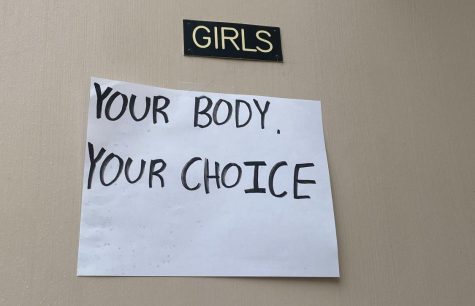Taft’s Dress Code Signifies the Imbalance of Female and Male Students in our School
The dress code at Taft is quite oppressive; it teaches our female students that their appearance is more important than their education. Furthermore, it teaches our male students that they are exempt from certain rules due to their gender. That treating women as objects is permissible. Although we cannot address every single comment or action that is oppressive, we can start by creating a school environment in which people are treated with the same respect and rights.
Our interpretation of the dress code at Taft, ridicules girls; shaming announcements targeting females, and PE shirts that let everyone know that they were punished for a simple thing; their wardrobe. The female students in our school are losing precious class time to go to the office and come back feeling humiliated, with everyone looking at them and judging them. It’s heartbreaking to see girls at our school cracked down on for their wardrobe while boys’ are treated with so much more respect. A female’s wardrobe is not harming anyone; there is no reason to highly regulate their clothing in the name of “discipline”.
Administrators are enforcing the dress code in order to prepare students for the “real world” workplace. Their reasoning is that in an office space, adults are expected to dress in a certain manner, but this has changed. Fifty years ago, tattoos would not be appropriate in an office setting. Nowadays, employers and businesses are more accepting of self-expression. If our administrators are preparing us for our future, why are their rules stuck in the past?
On the 2nd of October, Charisma Yousefzadeh, a student at Taft Charter High School, wore an outfit resembling Laila Ali, a female boxer, and daughter of Muhammad Ali, for the school’s “Hollywood Dress-up Day”. The outfit consisted of see-through pink shorts with black shorts underneath and a tank top. “I was in my first-period class, speaking to my teacher at her desk by the entrance of the classroom” Yousefzadeh recalled. “[An administrator] just happened to be walking past … She pulled me out of the classroom to tell me that I was being dress coded. I explained that I had shorts on underneath to cover myself and that even my mother had deemed my outfit acceptable enough to wear to school. I [still] had to leave school to get a different pair of pants, making me miss at least half an hour of class.”
Yousefzadeh’s story is not the only one. When talking with female peers in my grade there are many examples of girls who share similar experiences. This is not just a school-based problem either. Women in the workplace (or just out in the street) constantly feel the lingering eyes of people judging them, tolerating the leers and catcalls because we have blamed the woman for her outfit, not the society for its perceptions. Although this mindset of inequity is ingrained in our society and it is much larger than our school, change occurs on smaller scales. We must allow our female students to wear what they want, and tackle the responses. It is not the fault of the woman walking down the street that she is catcalled, it is the catcaller that needs to learn to make better more appropriate choices.
The biggest fear of removing the dress code is that the female population will be brought face to face with the “boys will be boys” mentality. We need to empower women rather than accept the toxic behavior. Teaching women to be afraid hasn’t worked, and to move forward we should tackle the issues head-on. Rather than allow the unintentional lessons that turn boys to creeps, we must find equality and expectations on a fair playing ground that benefits every gender.
Getting rid of the dress code could make Taft a more progressive school in which all students would truly be treated with the same respect.
Dress codes teach women that they must cover themselves up, in order for men and boys to not be distracted by their bodies. It teaches the men that its not their fault for glaring at women, that the women should be more modest. If this mindset is formed in our male students, they will go out into the world treating other women with less respect because they were taught that they have power over them. If we endeavor for our school to be a welcoming place filled with wonderful examples of equality, then why have we kept this rule that makes our female student body feel less important than their male peers?
This article is part of a series. Click here to view the other half of the series.
Do you support the school's dress code?
- No (74%, 73 Votes)
- Yes (26%, 25 Votes)
Total Voters: 98
Have you ever been dress coded at school?
- Never (56%, 49 Votes)
- Just once (17%, 15 Votes)
- A bunch! (17%, 15 Votes)
- A few times (10%, 9 Votes)
Total Voters: 88

A fighting feminist who will not tolerate any ignorance or idiocy.














Joshua Weingart • Nov 13, 2018 at 3:11 pm
Although I understand where your perspective comes from, and there is obviously an imbalance, I find it unreasonable to proclaim a universal all-encompassing dress code to be oppressive in any form. The dress code is designed to ensure that nobody, regardless of gender, wears anything conventionally inappropriate or risque. The purpose is not to oppress a certain group of people, but rather to ensure that people wear appropriate clothing at the school. It is the choice of the student to wear what they want, and because the clothing opportunities for men is relatively limited compared to women (shirt and shorts/pants is basically it) unless a man were to come to school with no shirt or pants they are probably less likely to get dress coded. Additionally, your statements that an unbiased and reasonable dress code is teaching women to adhere to very strict and extreme societal norms is founded off of very vague and not grounded logic and assumptions about the dress codes and its effects on women.
xenia • Nov 13, 2018 at 10:32 am
This is well written. The dress code is oppressive and needs to GET GONE!
Sean Emezi • Nov 6, 2018 at 6:13 am
We live in a new age where there should be equality for everyone but we don’t exactly have that. We’re making progress but this shows that we’re not quite there yet. Women have their choice as men have theirs. If a man was outside running without a shirt, no one would really pay attention but if a women did that, she’d probably get stopped by the police. Why? You may say the breasts, but still, why? Why are her breasts so inappropriate? What have they done? Again, I think we’re getting better but we’re not there yet.
Kate Ruderman • Nov 5, 2018 at 5:55 pm
I completely agree with this article. As a female student at Taft, I think that we shouldn’t be forced to dress a certain way so boys aren’t “distracted.” Rather than dress coding the girls and making them feel ashamed by wearing P.E. shirts the administration should take this chance to teach the boys to treat females with respect.
Tessa Temme • Nov 5, 2018 at 9:55 am
As a female at Taft High School, I haven’t felt personally restricted by the dress code since it is very poorly enforced.
In practice I have felt it fair; however, in writing – the Taft dress code offers guidelines that disproportionately affect women.
Restrictions such as the exposure of undergarments being a violation represents the imbalance.
Yasmin Shenassa • Nov 4, 2018 at 1:09 pm
I completely agree with this article. Our dress code makes it difficult for girls to wear the clothes that they want to wear. It’s very unfair that girls have to come to school each day worried about being dress coded.
Anna Mikhaylyants • Nov 4, 2018 at 1:07 pm
This article is very eye-opening to a lot of the students at Taft. As a girl, I have noticed many of my friends being dress-coded or getting warnings about their shirts being about an inch away from the top of their pants. It doesn’t make sense for our school to have a dress code that targets females, using the reasons of our bodies being distractions to boys. It’s 2018 and the advances made in our country with tolerance and acceptance are amazing, yet our school still doesn’t allow for a girl to show her belly button?
Melanie Piper • Nov 3, 2018 at 6:00 pm
I thought this article was very thorough, informative, and insightful regarding Taft’s dress code issue. You elaborated on the traditional arguments usually used against dress code while also incorporating new points of view I hadn’t seen before, such as your tattoo example. Great job!
David Lin • Nov 1, 2018 at 11:18 am
As a male Taft student, I never been dress coded and thus I have never considered the dress code an issue at Taft. However, this response brings to light what the dress code is like from a female perspective, and therefore I am now aware of how unfairly the dress code affects women.
Chelsy Monje • Oct 29, 2018 at 2:58 pm
I agree with this. And that’s the tea.